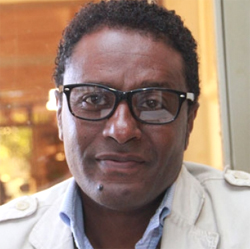Finding the lost treasures in films
 Mackonen Michael, filmmaker, is deeply immersed in the ancient civilization of Ethiopia, believing that to move forward one should reclaim the past. It is not only for personal reward.
Mackonen Michael, filmmaker, is deeply immersed in the ancient civilization of Ethiopia, believing that to move forward one should reclaim the past. It is not only for personal reward.
He conveys a message in his films by tracing the roots and digging deep to tell the unique stories. With this passion he has made three films: The Ethiopian Thinking, Sacred Art and Heaven and Earth: a Millennium of Monastic Culture. His passion for cinema came at an early age with his introduction to Indian films. He wanted to be an actor but he could not imagine competing in the mainstream world. Before embarking on his film career he produced many radio productions, and has also won a BBC World Service award. Completing a post-graduate in African Studies at the School of Oriental and African Studies (SOAS), University of London, he strongly believes in research as a way of life, to make films that bring about change. Based in England he has a company called Mack Film Production, mainly producing documentaries. On finishing his latest film, Heaven and Earth: a Millennium of Monastic Culture, Mackonen Michael sat down with Tibebeselassie Tigabu of The Reporter for an exclusive interview. Excerpts:
The Reporter: a couple of years ago you made a film entitled ‘The Ethiopian Thinking’, which was screened at the School of Oriental and African Studies in London (SOAS) and made quite an impression with the audience. What is the film about?
Mackonen Michael: It is a short, 23-minute-long documentary film. The idea came to me when I made Sacred Art, a documentary I had completed earlier.
That was an hour-long documentary film on the life of Ale Felegeselam, the founder of the Ethiopian Fine Arts school. As I carried out my research and filming, I discovered many things.
I did many interviews regarding Ale Felegeselam and on the ancient education of Ethiopia. I found a lot of information about Ethiopian ancient philosophy, education heritage and the Ge’ez language.
This ancient civilization is hidden away from the rest of the world, as well as Ethiopians. I was angry yet touched by that fact. In the places where I filmed there are manuscripts that are burnt but in good condition. I discovered medical books that discussed disease, although some of the books are ruined. It is a conundrum for me. I started to question what had happened.
I thought there was something inherently wrong with the owners of this heritage, the Cradle of Civilization, all of it over shad owed by poverty.
When I interviewed Richard Pankhurst (Prof.), Rita Pankhurst, Birhanu Gizaw (Ph.D.), Ale Felegeselam and the priests they told me many interesting facts. What happened? Why is there this sudden massive gap? We can’t even feed ourselves. Were we the makers and breakers, or was it just a fairytale? That is the concept of the film. It was extracted from Sacred Art. Read more



